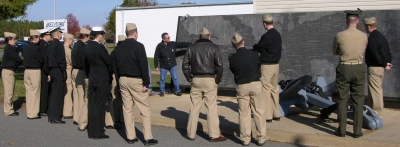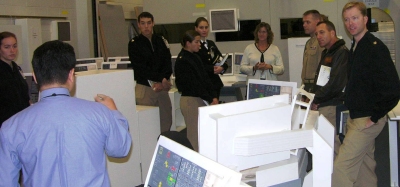
U.S. Naval Academy Midshipmen are briefed at the NSWC Dahlgren Potomac River Test Range on Nov. 19 during a tour that also featured the Electromagnetic Railgun, Integrated Warfare Systems Laboratory and the Human Performance Lab. The 20 midshipmen and four instructors toured the gun line where testing has been conducted since 1918 and stepped into laboratories designed to shape the Navy's future. "It's interesting to see how technologies are developed and applied to the actual Fleet in present and future operations - from the 1950s to Railgun," said Midshipman First Class Ben Bennett. U.S. Navy photo by Jon Dachos, NSWC Dahlgren Division Human Systems Integration Command Center Design Lead Engineer.
DAHLGREN, Va. (November 24, 2010)—The importance and impact of technology in the past, present and future Fleet have been subjects of intense study and discussion at U.S. Naval Academy classrooms since its inception.
What's more, Academy midshipmen embark on ships and submarines and become more familiar with the mission, tasks and equipment of the four largest naval warfare areas: Surface, Subsurface, Aviation and Marine Corps. As a result, they gain an experience and understanding of warfighting technologies the classroom could never offer.
This year, 20 midshipmen and four instructors from the Naval Academy added a one-day field trip to the Naval Surface Warfare Center at Dahlgren, Va., to their itinerary and saw how technological advancements and systems integration are transforming current and future warships - and their crews.
"It's exciting to see technology I'll be using in the future," said Midshipman First Class Conner Bench, from Seattle, Wash. "I was really impressed with the breadth of technical capabilities here."
"It's interesting to see how technologies are developed and applied to the actual Fleet in present and future operations - from the 1950s to Railgun," added Midshipman First Class Ben Bennett, a political science major.
Bench, Bennett and their classmates toured the gun line where testing has been conducted since 1918 and stepped into laboratories designed to shape the Navy's future with technologies such as the Electromagnetic Railgun.
They also saw the Integrated Warfare Systems Laboratory (IWSL) and the latest Human Systems Integration (HSI) advancements impacting warships. Human Factors engineers briefed the midshipmen on the proposed two final draft designs for the USS Gerald R. Ford (CVN-78) and USS Abraham Lincoln (CVN-72) Combat Direction Centers (CDC).
"The engineers from the IWSL, railgun, gun line, and the Human Performance Laboratory provided the midshipmen with a good overview of all the unique systems and platforms that Dahlgren brings to our nation," said Jon Dachos, NSWC Dahlgren HSI Command Center Design Lead Engineer. "Our team showed the midshipmen technology similar to what they're studying in their final year at the Academy - technology they'll be using in the very near future as Marine Corps or Navy officers."

U.S. Naval Academy Midshipmen are briefed at the NSWC Dahlgren Human Performance Lab on Nov. 19 during a tour that also featured the Electromagnetic Railgun, Integrated Warfare Systems Laboratory and the Potomac River Test Range. The 20 midshipmen discussed human performance and combat systems with Navy scientists and engineers. They gained a knowledge and understanding of the Navy's Human Systems Integration process that includes modeling and simulation, small and large scale mock-up, 3D human factors engineered CAD (computer-aided design) walkthroughs, and relevant Fleet participation in warfare scenarios to verify the USS Gerald R. Ford CDC design layout. U.S. Navy photo by Jon Dachos, NSWC Dahlgren Division Human Systems Integration Command Center Design Lead Engineer.
Midshipmen talked about combat systems with Navy scientists and engineers, asking questions they may not have been able to ask in class about new and developing systems they are reading about in their textbooks.
"It's really great for the class to see new technology that they've heard about at the place where it is under development," said Naval Academy instructor Lt. Cmdr. Ellery Blood. "The tours were excellent and gave the students a lot of good information to take back with them."
For example, midshipmen took back knowledge and understanding of the Navy's HSI process that includes modeling and simulation, mock-up (small and large scale), 3D human factors engineered CAD (computer-aided design) walkthroughs, and relevant Fleet participation in warfare scenarios to verify the USS Gerald R. Ford CDC design layout.
"A tour like this offers the opportunity to talk to the builder and designer," said Dachos. "The teaching staff also left with ideas on how to update their curriculum. This offers another chance for Dahlgren to support the Fleet by providing updates to the combat system material taught to 1,000 midshipmen per year in the principles of Naval Weapons Systems course of Instruction for the U.S. Naval Academy, Officer Candidate School, and Reserve Officer Training Corps. All programs use the same textbook."
Background on the major technological programs briefed to U.S. Naval Academy midshipmen and their instructors:
— Electromagnetic railguns provide a capability for sustained, offensive power projection, complementary to missiles and tactical aircraft. They may be a cost-effective solution to the Marine Corp Naval Surface Fire Support requirements because of their unique capability to simultaneously satisfy three key war-fighting objectives: extremely long ranges, short time-of-flight and high lethality (energy-on-target) .
—The Integrated Warfare Systems Laboratory (IWSL) is the principle Navy facility supporting computer program engineering for operational Aegis cruisers and destroyers. Although its mission is to provide a site adequately equipped and staffed to support the Lifetime Support Engineering Agent in generating, maintaining, updating, and certifying Aegis Combat System computer programs, the facility is broadening its business base with the addition of other programs, customers, and labs. Primarily, the IWSL provides the Aegis fleet, warfighters, and community with the facilities and support services to generate, test, integrate, and deliver quality-assured Aegis tactical, simulation, support, and training computer programs. All computer programs delivered to operational Aegis ships come from the IWSL. The facility houses shipboard computers, displays, and peripherals, along with simulation, program generation, data reduction, systems analysis, configuration management, and communications equipment.
— The Integrated Command Environment (ICE) and Human Performance Laboratory (HPL) team and facilities, due to the location at NAVSEA Dahlgren and partnership with the Center for Surface Combatant Systems (CSCS), provide a valuable link between science and technology, research and development activities, and the acquisition and Fleet communities. Performing research in the context of operational needs ensures Fleet interest and participation, appropriate focus, and a clear transition path. Strong Fleet participation (1,500 officer and enlisted participants in the last five years) and human systems engineering expertise have been key to the success of the ICE/HPL.
The ICE/HPL team's focus is human performance, stressing optimization of manpower, usability, maintainability, decision support, and knowledge superiority in an effort to enhance the capabilities of our warfighters and improve total system performance and affordability over the entire life-cycle of a platform or system. A sound, systems engineering approach is applied to problems, emphasizing that a system is not only composed of hardware and software but also includes the human operators, maintainers, decision makers, and the shore support infrastructure manpower.
— The Potomac River Test Range gun line: Since 1918 Dahlgren has been an important national resource for the testing of naval guns and ammunition as well as for a wide variety of military testing and training efforts utilizing explosive and non-explosive ordnance. Highlights of Dahlgren's ordnance work include test-firing every type of naval gun and its ammunition, and conducting a variety of short-term programs, such as serving as a bombing range for military pilot training during World War II. Dahlgren has two range complexes where most ordnance is tested: the Potomac River Test Range and the Explosives Experimental Area.
In recent years, efforts to use modeling and simulation test methods whenever possible have significantly diminished the level and type of operations. However, some level of live gunfire and explosives testing will be necessary, resulting in noise that is audible beyond the confines of the installation. Guns shoot multiple bursts or intermittent single rounds and detonations are usually heard as booms or rumbles. Scheduled operations can be accessed by visiting the NSWC Dahlgren Division website at www.navsea.navy.mil/nswc/dahlgren/RANGE/rangeschedule.aspx or by calling our toll-free number at 1-877-845-5656.
— Electromagnetic railguns provide a capability for sustained, offensive power projection, complementary to missiles and tactical aircraft. They may be a cost-effective solution to the Marine Corp Naval Surface Fire Support requirements because of their unique capability to simultaneously satisfy three key war-fighting objectives: extremely long ranges, short time-of-flight and high lethality (energy-on-target) .
—The Integrated Warfare Systems Laboratory (IWSL) is the principle Navy facility supporting computer program engineering for operational Aegis cruisers and destroyers. Although its mission is to provide a site adequately equipped and staffed to support the Lifetime Support Engineering Agent in generating, maintaining, updating, and certifying Aegis Combat System computer programs, the facility is broadening its business base with the addition of other programs, customers, and labs. Primarily, the IWSL provides the Aegis fleet, warfighters, and community with the facilities and support services to generate, test, integrate, and deliver quality-assured Aegis tactical, simulation, support, and training computer programs. All computer programs delivered to operational Aegis ships come from the IWSL. The facility houses shipboard computers, displays, and peripherals, along with simulation, program generation, data reduction, systems analysis, configuration management, and communications equipment.
— The Integrated Command Environment (ICE) and Human Performance Laboratory (HPL) team and facilities, due to the location at NAVSEA Dahlgren and partnership with the Center for Surface Combatant Systems (CSCS), provide a valuable link between science and technology, research and development activities, and the acquisition and Fleet communities. Performing research in the context of operational needs ensures Fleet interest and participation, appropriate focus, and a clear transition path. Strong Fleet participation (1,500 officer and enlisted participants in the last five years) and human systems engineering expertise have been key to the success of the ICE/HPL.
The ICE/HPL team's focus is human performance, stressing optimization of manpower, usability, maintainability, decision support, and knowledge superiority in an effort to enhance the capabilities of our warfighters and improve total system performance and affordability over the entire life-cycle of a platform or system. A sound, systems engineering approach is applied to problems, emphasizing that a system is not only composed of hardware and software but also includes the human operators, maintainers, decision makers, and the shore support infrastructure manpower.
— The Potomac River Test Range gun line: Since 1918 Dahlgren has been an important national resource for the testing of naval guns and ammunition as well as for a wide variety of military testing and training efforts utilizing explosive and non-explosive ordnance. Highlights of Dahlgren's ordnance work include test-firing every type of naval gun and its ammunition, and conducting a variety of short-term programs, such as serving as a bombing range for military pilot training during World War II. Dahlgren has two range complexes where most ordnance is tested: the Potomac River Test Range and the Explosives Experimental Area.
In recent years, efforts to use modeling and simulation test methods whenever possible have significantly diminished the level and type of operations. However, some level of live gunfire and explosives testing will be necessary, resulting in noise that is audible beyond the confines of the installation. Guns shoot multiple bursts or intermittent single rounds and detonations are usually heard as booms or rumbles. Scheduled operations can be accessed by visiting the NSWC Dahlgren Division website at www.navsea.navy.mil/nswc/dahlgren/RANGE/rangeschedule.aspx or by calling our toll-free number at 1-877-845-5656.


